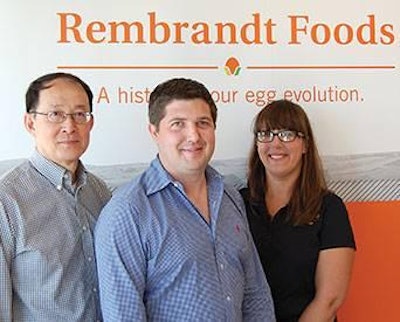
One step forward in the process of the planned transformation from an egg products company to value-added ingredients supplier occurred this year when Rembrandt Foods opened a new research and development facility adjacent to its Spirit Lake, Iowa, headquarters. The research and development team that Rembrandt has put together will use the new facility to find new uses for the components of eggs as food ingredients.

Mark Nelson, pilot plant manager, spray dries egg whites at Rembrandt Foods' new research and development facility.
The other side of the egg white craze
Prior to the avian influenza outbreak, demand for egg whites in the U.S. soared. Introduction of egg white products for use in omelets and in McDonald’s Egg White Delight McMuffin pushed prices for egg whites to record high levels. Jonathan Spurway, marketing vice president, Rembrandt Foods, said that up until three years ago, egg yolk was more valuable than egg whites in the U.S., but that has changed. The egg white craze hasn’t taken hold in Europe, at least not yet, and yolk is still more valuable than whites are there.
Rembrandt is looking at components of yolk to see if these can be extracted and marketed in new ways to upgrade the return on egg yolk. This is somewhat like what broiler companies are doing to try and upgrade returns on dark meat, but they aren’t doing it at as a molecular level as Rembrandt is.
The dairy industry was confronted with a similar problem with finding uses for whey, which is a byproduct of making cheese. Spurway said the dairy industry undertook research and development projects to find uses for whey as a food ingredient, with remarkable success. The same consumer-driven protein craze that has increased demand for egg whites has pushed whey powder prices up as well; so much so that Spurway joked that cheese may now be a byproduct of making whey.
Spurway said, “Around 30 years ago, the egg industry didn’t take the same research and development path as the dairy industry. In the last 10 to 15 years, the dairy industry has really taken off around the protein story.” He said that the dairy industry has developed uses and markets for whey protein concentrates and isolates for the sports and health nutrition markets.
Egg protein, the gold standard
Spurway explained that the egg industry is behind the dairy and soy industries in developing new markets. Rembrandt plans to use its new research and development capabilities to catch up.
Dr. Jimbin Mai, research and development vice president, Rembrandt Foods, said, “Egg protein is the most complete, the gold standard.” He said that the dairy industry has paved the road for Rembrandt by doing a lot of the development work. “It makes it easier for us to catch up than if we were pioneers in the protein space,” he said.
An egg isn’t just an egg; it is a collection of proteins, lipids and other nutrients. Mai said that, in addition to being the most complete source of protein, the egg is still the most efficient way of producing animal protein. Vegetable protein and fat sources will be the low-cost competitors for egg, but they lack many of the nutritional and functional properties of egg.

Jihan Cepeda, product development scientist, conducts texture analysis on a yellow cake sample containing dried whole egg to check functionality at Rembrandt Foods new research and development facility.
Functional properties of eggs
From a nutritional standpoint, egg products are unique. The egg can provide all of the nutrients needed to feed the embryo. But eggs have more than just nutritional value for food manufacturers; the functional properties of eggs -- yolks for making emulsions and whites for aeration and gelling -- are important as well.
Egg yolk is 30-40 percent protein and it is rich in choline. Choline is bound to a phospholipid, and phospholipids are easily absorbed and utilized. Some of the nutrients found in high quantities in eggs, like choline, could become valuable ingredients in high-nutrition foods and supplements, according to Spurway.
“What protein can we pull from our egg and put in a sports nutrition or infant nutrition product?” he asked. “This is a market we haven’t been in yet.” One example he cited is an extruded egg yolk protein product that could be included in protein bars as a “crisp.”
Spurway said: “We need to focus not just on what the customer (food processor) wants but also on what the consumer wants. We aren’t just about the egg; we can bring other ingredients to our customers.” In the past, Spurway said Rembrandt Foods just sold eggs, now they are moving to selling functional properties and nutrition.

The test kitchen at Rembrandt Foods' Spirit Lake, Iowa, headquarters allows food scientists to fully test the functionality of egg products coming from the pilot plant.
With the easing of dietary recommendations regarding egg consumption and cholesterol, perhaps the value of yolks will rebound relative to egg whites. Rembrandt is looking for solutions that will put more eggs and better nutrition into our diets in what may be new and surprising ways. This is all part of the process of what Spurway described as the planned transformation of Rembrandt into “the leading value-added egg ingredients company globally.”


















